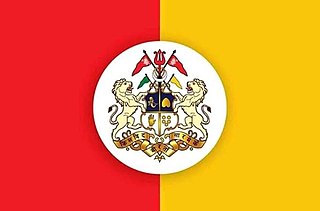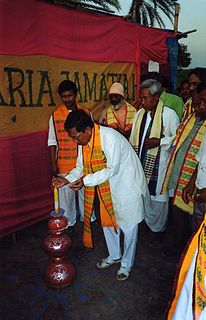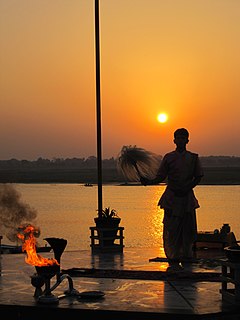Related Research Articles

The Tripuri are an ethnic group originating in the Indian state of Tripura. They are the original inhabitants of the Twipra/Tripura Kingdom in North-East India and Bangladesh. The Tripuri people through the Manikya dynasty ruled the Kingdom of Tripura for many years until the kingdom joined the Indian Union on 15 October 1949.

The Tripuri people are the original inhabitants of the state of Tripura in North East India. The Tripuri people through the Royal family of the Debbarmas ruled the state of Tripura for more than 1400 years till the kingdom joined the Indian Union in 1949. The Tripuris constitute the weightiest section of the entire indigenous population of the State of Tripura.

Debbarma The DebBarma is the one of the clan of Tripuri community, predominantly in Tripura state, India and Bangladesh, they speak Kokborok which is Tibeto-Burman languages. They belong to Kshatriya varna.

The Jamatia's are one of the main Tripuri clans of Tripura and the only such clan with its own Customary Law in Practice, which is called Jamatia Customary Laws Act, 2017.

Jamatia Hoda is the institution that looks after the rights and safeguard of the culture of the Jamatia clan of Tripuri community. It has head-office in Atharobla in Udaipur town of South Tripura district of Tripura and a branch office at Khejurbagan, Agartala near Sri Krishna Mission School. It has also started a higher secondary school Garia Academy in Atharobla.
Reang (Bru) are one of the Tripuri clan of the Indian state of Mizoram and Tripura. The Bru can be found all over the Tripura state in India. However, they may also be found in Assam. They speak the Reang dialect of Kokborok language which is of Tibeto-Burman origin and is locally referred to as Kau Bru.
Goria Ter is observed for seven days by indigenous Tripuri, honoring universal god Baba Goria, beginning on the last day of Chaitra until Hari Buisu. The first day of the puja is called 'Moha Buisu' and the day of immersion is called 'Sena'. The articles that are essential during the puja are kept strictly under lock in the house of Kherphang as per the rule of the Goria puja.
The indigenous people of Bangladesh refer to ethnic minorities in Chittagong Hill Tracts (southeastern), Sylhet Division (northeastern), Rajshahi Division (northwestern), and Mymensingh District (north-central) areas of the country. The total population of indigenous ethnic minorities in Bangladesh was estimated to be over 2 million in 2010. They are diverse ethnic communities including Tibeto-Burman, Austric and Dravidian people.

Nuakhai or Navakhai or is an agricultural festival mainly observed by people of Western Odisha and Southern Chhattisgarh in India. Nuakhai is observed to welcome the new rice of the season. According to the calendar it is observed on panchami tithi of the lunar fortnight of the month of Bhadrapada or Bhadraba (August–September), the day after the Ganesh Chaturthi festival. This is the most important social festival of Western Odisha and adjoining areas of Simdega in Jharkhand, where the culture of Western Odisha is much predominant.

Culture of Tripura is distinct and a bit similar to other people of Northeast India. However like Assam, Manipur, Burma and Southeast Asia culture of Tripura is characterized in small portion living in plain areas notably the Tripuri culture. Tripura is a state in North East India. In the 2001 census of India, Bengalis represented almost 70% of the population and the Tripuri population comprised 30% of Tripura's population. The Tripuri population comprises some clans and ethnic groups with diverse languages and cultures. The largest native group was the Tripuri who had a population of 543,848 in 2001 census, representing 16.99% of the state population and 54.7% of the scheduled tribe population. The other group of people in order of decreasing population were Chakma (6.5%), Halam (4.8%), Mog (3.1%), Munda, Kuki tribes and Garo Hajong. Bengali is the most spoken language, due to the dominance of Bengali people in the state. Kokborok (Tripuri/Tiprakok) is a common language among Tripuris and lingua franca among tribes. Several other languages belonging to Indo-European and Sino-Tibetan families are spoken by the different tribe
Rongker is an annual winter time festival of merriment observed by the Karbis of Assam. It is also known as Dehal in Dumra Longri i.e. Kamrup Metropolitan district of Assam and Ri-Bhoi district of Meghalaya. It is observed in order to appease the local deities, associated with the welfare of the village and the harvest of crops and also to get rid of all evil happenings.

Hojagiri is a folk dance, performed in the state of Tripura, India by Tripuri people of Reang clan. It is performed by women and young girls, about 4 to 6 members in a team, singing, balancing on an earthen pitcher and managing other props such as a bottle on the head and earthen lamp on the hand. while only the lower half of the body is moved.
Goria dance or Garia dance is a dance of the Tripuri people of the Indian state of Tripura. It is performed during Goria puja, the festival to celebrate the sowing of new crops and prayer for a good harvest during the month of Baisakha. In the western calendar, the dancing occurs after the middle of April. As well as the Tripuri people themselves, the dance also occurs amongst neighbouring peoples of Tripuri such as the Jamatia, Reang and Noatia. Both sexes take part in the dance accompanied by drums and flutes. The dance begins with a slow rhythm, gradually increasing in tempo as the dance progresses from one village to another. It involves many hand movements and some whirling. The dancers also sing in chorus. There are more than two-dozen mudra (movements) in the dance many of which represent the movements of animals and birds or other features of nature.
Lebang Boomani dance is a harvest dance performed by the Tripuri people of Tripura, India. It is one of two dances associated with the Tripuris, the other being the Garia dance that is performed at the time of sowing crops.
Mamita dance is a dance of Tripura, India. It is performed at the Mamita Festival, the harvest festival of the Tripuri people.

Ganga puja is a religious festival of the northeastern state of Tripura in India. The tribal Tripuri people worship the Goddess of the river, and pray to be saved from epidemic diseases and for the well-being of pregnant women. The celebration involves building a temple of bamboo in the middle of the river or a water stream. The River Ganges, known locally as Ganga, is one of the fourteen prime deities worshipped in this region. The festival is popularly celebrated throughout the state somewhere in March, April or May, with its date fixed according to the Hindu Lunisolar calendar. The 2018 date is 24 May.
Kharchi Puja is a Hindu festival from Tripura, India. Performed in Agartala in July or August, the festival involves the worship of the fourteen gods forming the dynasty deity of the Tripuri people. Kharchi Puja is one of the most popular festivals in Tripura. It's a week-long royal Puja which falls in the month of July on the eighth day of the new moon and attracts thousands of people. This festival is celebrated at Agartala in the temple premises of Fourteen gods. There are many legends associated with this Puja. The celebrations extend until a week and are held in the temple premises which are attended by thousands of people.
Kokborok Day is a festival celebrated in the Indian state of Tripura to celebrate the development of the Kokborok language. It is observed on 19 January every year. The Kokborok language is an official language in Tripura. This day is chosen to commemorate its initial recognition as an official language in 1979. The activities include cultural programmes and literary activities.
Mamita may refer to:

The Chaturdasa Devata or Fourteen Gods is the Shaivite Hindu pantheon worshipped in the Indian state of Tripura.
References
- ↑ Encyclopaedia of Fairs & Festivals in India Soma Deb, B. Sinha - 2001 Mamita Festival This festival is observed in the Tripura state by the tribals like Jamatia, Tripura, and Noatia. Though there is no particular date for the celebration, but it is performed immediately after the harvesting is over, usually in the months of October— November every year.
- ↑ Oral tradition and folk heritage of North East India - 8187502029 Lalit Kumar Barua - 1999 Page 168 - Some tribes like the Jatias, Tripuri and Jamatia observe another festival connecting the harvest, namely Mamita festival which is the worship of a particular deity.